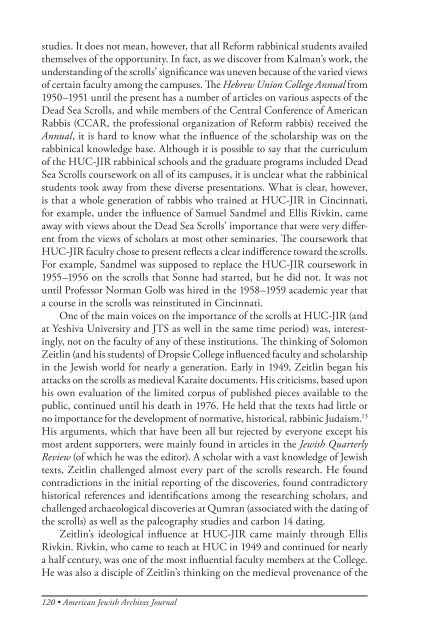The American Jewish Archives Journal, Volume LXI 2009, Number 1
The American Jewish Archives Journal, Volume LXI 2009, Number 1
The American Jewish Archives Journal, Volume LXI 2009, Number 1
Create successful ePaper yourself
Turn your PDF publications into a flip-book with our unique Google optimized e-Paper software.
studies. It does not mean, however, that all Reform rabbinical students availed<br />
themselves of the opportunity. In fact, as we discover from Kalman’s work, the<br />
understanding of the scrolls’ significance was uneven because of the varied views<br />
of certain faculty among the campuses. <strong>The</strong> Hebrew Union College Annual from<br />
1950–1951 until the present has a number of articles on various aspects of the<br />
Dead Sea Scrolls, and while members of the Central Conference of <strong>American</strong><br />
Rabbis (CCAR, the professional organization of Reform rabbis) received the<br />
Annual, it is hard to know what the influence of the scholarship was on the<br />
rabbinical knowledge base. Although it is possible to say that the curriculum<br />
of the HUC-JIR rabbinical schools and the graduate programs included Dead<br />
Sea Scrolls coursework on all of its campuses, it is unclear what the rabbinical<br />
students took away from these diverse presentations. What is clear, however,<br />
is that a whole generation of rabbis who trained at HUC-JIR in Cincinnati,<br />
for example, under the influence of Samuel Sandmel and Ellis Rivkin, came<br />
away with views about the Dead Sea Scrolls’ importance that were very different<br />
from the views of scholars at most other seminaries. <strong>The</strong> coursework that<br />
HUC-JIR faculty chose to present reflects a clear indifference toward the scrolls.<br />
For example, Sandmel was supposed to replace the HUC-JIR coursework in<br />
1955–1956 on the scrolls that Sonne had started, but he did not. It was not<br />
until Professor Norman Golb was hired in the 1958–1959 academic year that<br />
a course in the scrolls was reinstituted in Cincinnati.<br />
One of the main voices on the importance of the scrolls at HUC-JIR (and<br />
at Yeshiva University and JTS as well in the same time period) was, interestingly,<br />
not on the faculty of any of these institutions. <strong>The</strong> thinking of Solomon<br />
Zeitlin (and his students) of Dropsie College influenced faculty and scholarship<br />
in the <strong>Jewish</strong> world for nearly a generation. Early in 1949, Zeitlin began his<br />
attacks on the scrolls as medieval Karaite documents. His criticisms, based upon<br />
his own evaluation of the limited corpus of published pieces available to the<br />
public, continued until his death in 1976. He held that the texts had little or<br />
no importance for the development of normative, historical, rabbinic Judaism. 13<br />
His arguments, which that have been all but rejected by everyone except his<br />
most ardent supporters, were mainly found in articles in the <strong>Jewish</strong> Quarterly<br />
Review (of which he was the editor). A scholar with a vast knowledge of <strong>Jewish</strong><br />
texts, Zeitlin challenged almost every part of the scrolls research. He found<br />
contradictions in the initial reporting of the discoveries, found contradictory<br />
historical references and identifications among the researching scholars, and<br />
challenged archaeological discoveries at Qumran (associated with the dating of<br />
the scrolls) as well as the paleography studies and carbon 14 dating.<br />
Zeitlin’s ideological influence at HUC-JIR came mainly through Ellis<br />
Rivkin. Rivkin, who came to teach at HUC in 1949 and continued for nearly<br />
a half century, was one of the most influential faculty members at the College.<br />
He was also a disciple of Zeitlin’s thinking on the medieval provenance of the<br />
120 • <strong>American</strong> <strong>Jewish</strong> <strong>Archives</strong> <strong>Journal</strong>

















